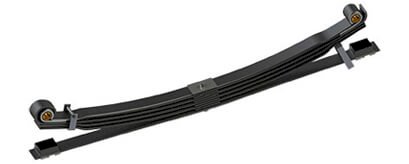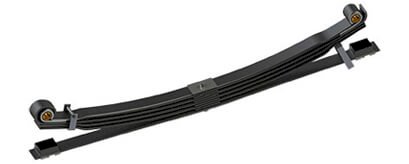Parabolic Leaf Springs: Enhancing Ride Comfort and Stability
Leaf springs have been an integral part of the automotive industry for centuries, providing a reliable suspension system for various vehicles.

Leaf springs have been an integral part of the automotive industry for centuries, providing a reliable suspension system for various vehicles. Among the different types of leaf springs, parabolic leaf springs have gained popularity due to their ability to enhance ride comfort and stability. Let’s explores the features and benefits of parabolic leaf springs, their design and construction, and their impact on improving the overall performance of vehicles.
I. Understanding Parabolic Leaf Springs
Parabolic leaf springs are a variation of traditional multi-leaf springs, distinguished by their unique shape and design. Unlike conventional leaf springs, which consist of multiple layers of progressively shorter leaves, parabolic leaf springs have leaves that are progressively shorter and tapered towards the ends. This tapering creates a parabolic curve, giving these springs their name.
The parabolic shape of these leaf springs offers several advantages. Firstly, it allows for a more flexible suspension system, as the longer central portion of the spring can absorb shocks and vibrations more effectively. Secondly, the tapered design reduces the overall weight of the spring, making it lighter than traditional leaf springs. This weight reduction contributes to improved fuel efficiency and handling.
II. Enhanced Ride Comfort
One of the primary benefits of parabolic leaf springs is their ability to enhance ride comfort. The parabolic shape and tapered design enable the leaf springs to provide a more progressive spring rate. This means that they can effectively absorb smaller bumps and road irregularities while remaining firm enough to handle larger impacts.
The flexibility of parabolic leaf spring allows them to distribute the load more evenly across the entire length of the spring, resulting in reduced vibration and improved stability. This translates into a smoother ride, minimizing discomfort for passengers and reducing driver fatigue.
Moreover, the parabolic shape also helps in reducing axle hop, which occurs when the wheels lose traction and rapidly move up and down. The progressive spring rate of parabolic leaf springs helps to control axle hop, providing better traction and stability, particularly during acceleration or sudden braking.
III. Improved Handling and Stability
In addition to enhancing ride comfort, parabolic leaf springs also contribute to improved handling and stability of vehicles. The unique design of these springs ensures better weight distribution, allowing the vehicle to maintain proper balance during cornering and maneuvering.
Parabolic leaf springs offer a higher degree of lateral stability compared to conventional leaf springs. The tapered design minimizes lateral movement and sway, enhancing the vehicle's ability to maintain its intended line and reducing body roll. This increased stability is especially beneficial for trucks, trailers, and heavy-duty vehicles that are prone to lateral forces.
Furthermore, the progressive spring rate of parabolic leaf springs helps in load management. When the vehicle is unloaded or lightly loaded, the springs offer a softer initial rate, providing a more comfortable ride. However, as the load increases, the springs progressively stiffen, maintaining proper ride height and preventing excessive sagging. This characteristic is particularly advantageous for vehicles involved in commercial applications or towing heavy loads.
 Parabolic leaf springs have emerged as a significant advancement in suspension technology, offering improved ride comfort and stability. Their unique design and progressive spring rate allow for better load management, enhanced handling, and reduced vibration. Whether it's for passenger cars, trucks, or heavy-duty vehicles, parabolic leaf springs provide a reliable and efficient suspension system. As automotive engineering continues to evolve, the use of parabolic leaf springs is expected to become more widespread, further enhancing the overall driving experience for vehicles of all types.
Parabolic leaf springs have emerged as a significant advancement in suspension technology, offering improved ride comfort and stability. Their unique design and progressive spring rate allow for better load management, enhanced handling, and reduced vibration. Whether it's for passenger cars, trucks, or heavy-duty vehicles, parabolic leaf springs provide a reliable and efficient suspension system. As automotive engineering continues to evolve, the use of parabolic leaf springs is expected to become more widespread, further enhancing the overall driving experience for vehicles of all types.






































